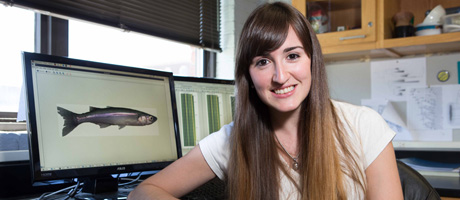Growing up in Argentina, Daniela Campanella, a doctoral candidate in biological sciences, fished the fresh lagoons of the Pampas Region with her father and grandfather, catching and eating the fish Odontesthes bonariensis, commonly known as the pejerrey.
What she didn’t know on those family fishing trips is that the pejerrey would not only nourish her body, but her mind as well. This spring, Campanella was the first person to successfully sequence the entire genome of the pejerrey, a fish with temperature-dependent sex determination—a discovery that will impact research around the world.
“What I enjoy the most about my PhD research is that every stage is a challenge,” said Campanella. “I find myself doing something I have never done before, and I love that feeling.”
Born and reared in Florencio Varela, about 35 kilometers south of Buenos Aires, Campanella spent her weekends pitching tents on the banks of nearby lagoons with her family while her father and grandfather fished small pejerreyes native to that region. As an undergraduate at Universidad Nacional de La Plata, she became a scientific angler, using the pejerrey as a test subject on marking techniques for aquaculture efficiency monitoring. She collaborated with researchers at the IIB-INTECH Conicet, Unsam Institute in Chascomús, Buenos Aires, who are experts on a unique attribute of the species: its gender is determined by its environment.
“During the first five weeks of the fish larvae stage, when the gonads are developing, the temperature of the water has an effect on sex determination,” explained Campanella. “If water temperature reaches 17 degrees Celsius, the new population will be 100% female. On the other hand, if temperature reaches 29 degrees, the fish will all be males. Temperatures in between will result in populations with a mixed ratio of females and males.”
Campanella chose GW for her doctoral work because she wanted to work with Weintraub Professor of Biology Guillermo Orti, an evolutionary biologist, expert in molecular systematics and phylogeography (the study of the relations between gene genealogies and their geographic location), and a highly regarded scientist.
“Daniela Campanella was highly recommended by my colleague and collaborator in Argentina, where she had already been studying this species with an ecological focus,” said Orti. “When she came to GW in fall of 2010, she immediately began working in my lab. In addition to the genome project, Daniela has been sequencing genes from other species of pejerreyes to build a genealogical tree (phylogeny) for the whole order.”
For her dissertation, Campanella is creating that phylogeny and comparing eight genes in the pejerrey and closely related species from its family and other families in the same order. She is also sequencing, assembling, and analyzing the entire pejerrey genome in collaboration with the researchers at IIB-INTECH Conicet, Unsam. Dr. Elisabet Caler, currently a program officer at National Institutes of Health, has provided Campanella with the bioinformatics training and computational tools she requires to work on the genome at the J. Craig Venter Institute in Rockville, Maryland.
By sequencing the pejerrey genome, Campanella will provide insight into evolutionary relations within the fish’s order, Atheriniformes, which contains more than 500 species.
“The impact of developing Odontesthes bonariensis genomic resources could be large,” said Orti. “It will provide genetic resources to improve the efficiency of this species in aquaculture for use in table food production and to seed lakes in many countries, including Argentina, Bolivia, Perú, Japan, and Italy. The genome will also improve this model system for fish endocrinology and sex determination studies. Comparative genomics, combined with experimental endocrinology, will shed light into the origin, significance, and maintenance of this unique natural history trait.”
The field of comparative genomics is growing exponentially as new DNA sequencing technology expands and costs drop. Orti’s lab is part of the Genome 10K, which aims to create a database of vertebrate genome sequences as a resource for science and worldwide conservation efforts. Campanella’s pejerrey genome sequence has been added to the Genome 10K project and will help inform the work of other biologists around the globe.
“I never imagined having a whole genome of this nature as my thesis work,” said Campanella. “A few years ago, this was unthinkable, but technology, collaboration, and teamwork made it possible. And the best thing is that this genome will be accessible to and help researchers from other fields.”
Photograph by William Atkins


